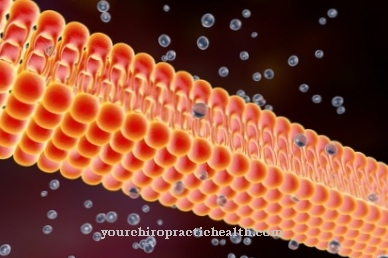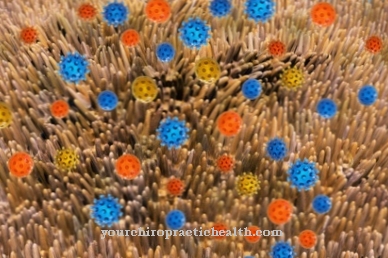The term Pinocytosis goes back to the Greek word “pinein”, which is translated with the German verb “to drink” and “kytos”, which means “cavity” or “cell”. Cells absorb liquids (pinocytosis) and solid substances (phagocytosis) in the form of small bubbles from their surrounding medium.
What is pinocytosis?

Two synonyms of the term are Cell drinking and Hydrophatocytosis. Pinocytosis absorbs fluid and phagocytosis absorbs solid components from the extracellular space. Both processes are summarized under the generic term endocytosis.
The absorption of liquid into the cell plasma takes place in the form of small vesicles that are only 150 nm in diameter. The liquid or dissolved components are absorbed into the cystole of the cells. Membrane extensions enclose the substance to be taken up, where it is taken up as vesicles into the cystole of the cell. There it is processed enzymatically. The absorbed substances are included in the metabolism of the cells.
Pinocytosis plays an important role in the absorption of protein-bound fats in hepatocytes and enterocytes. In the reverse process, the absorbed fluids are released from the cell again. This is a biological process that is assigned to the field of cell biology (cytology).
Function & task
Through endocytosis, macromolecules and larger particles are taken up into the cells.This process occurs through transport vesicles (small vesicles). The signal molecules are bound to the cell surface, the cell membrane is inverted and the absorbed content is enclosed. An endosome in the form of a vesicle forms in the cell. Thousands of these tiny bubbles are now transporting the charge through the cell, either being recycled or broken down.
This cell process enables the controlled absorption of liquids and solids. Pinocytosis plays an important role in cell and tissue development, the immune response, cell communication and signal transduction. It is also involved in signal transmission in the neural areas.
Microorganisms can be repelled, although it cannot be ruled out that harmful microorganisms and viruses can get into the cells via the endocytic transmission path. Phagocytosis internalizes larger particles such as leukocytes and macrophages. It disposes of degenerate cells, extacellular deposits and is used for food intake.
In pinocytosis, extracellular fluid is absorbed together with the substances dissolved in it. Then the fluid and the solutes are internalized. Medicine also calls this process Fluid phase endocytosis.
The eukaryotic cells know four different types of pinocytosis: clathrin-dependent endocytosis, macropinocytosis, caveolae and clathrin-independent endocytosis and caveolae-mediated endocytosis.
In macropinocytosis, plasma membranes with long membrane protuberances fuse to trap a large amount of extracellular fluid. Clathrin-dependent endocytosis internalizes extracellular molecules. During this process, important substances such as iron are absorbed by the human organism. A caveolae is an invagination of the plasma membrane in the shape of a bottle. It fulfills many functions within the cell and is responsible for signal transduction. The internalization of the caveolae within the cells is slow. For this reason, caveolae-mediated endocytesis only absorbs small amounts of extracellular fluid. Clathin-independent mechanisms are located in neurons and neuroendocrine cells, where they support the re-absorption of proteins into the plasma membrane.
With the reverse process of exocytosis, the vesicle is released from the cell again. The word component "exo" means "out". The membrane of a bubble (vesicle) fuses with a cell membrane, which allows the substance absorbed by the bubble to escape. This process is stimulated by certain membrane receptors.
Some cells are able to internalize 25 percent of their membrane, always returning the same amount of membrane. This process occurs mostly through clathrin-coated vesicles that fuse with endosomes. Lipid membranes form the basis for the vesicles that close off a lumen (clear width of a cell). By constricting cell compartments, the vesicles migrate to their destination in order to fuse with the cell membrane. Proteins help in this process by constricting a vesicle from a flat membrane.
Illnesses & ailments
In pinocytosis, the ingested food is first absorbed by droplets in an ambient medium in the food vacuole. Ingested food is digested by lysosomes (vesicles) containing digestive enzymes based on a fusion between the membrane and the food vacuole. Pinocytosis transfers the digested food from the digestive vacuole into the cell's plasma. Food residues that cannot be digested are transported to the cell membranes by means of a defecation vacuole and emptied outside.
If this process is disturbed, various diseases can occur which are attributed to a defect in the membrane transport. Dementia, Alzheimer's, metabolic disorders, high cholesterol levels, neurological diseases (restricted muscle reflexes, sensory disorders), Huntington's disease (death of nerve cells), changes in personality and various types of physical and mental disabilities, such as Charcot-Marie-Tooth neuropathy Syndrome, related to faulty pinocytosis.












.jpg)



.jpg)










.jpg)
